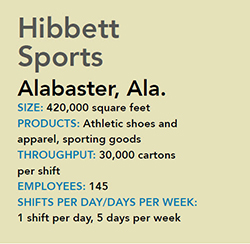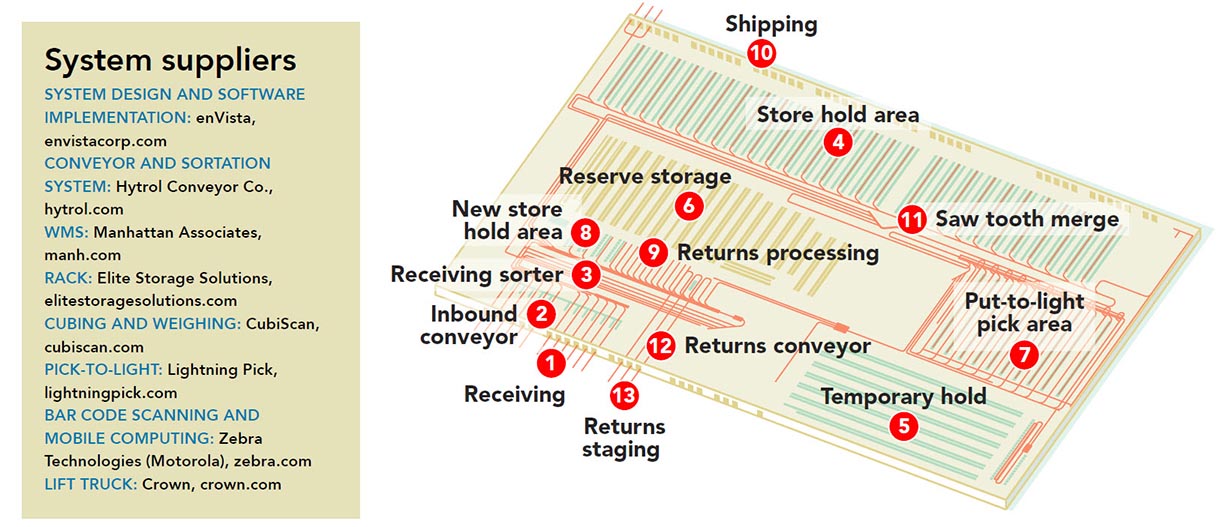Hibbett Sports: Managing the flow
Hibbett Sports’ new Alabama facility features a high-speed conveyor and sortation system to crossdock as much as 80% of incoming merchandise, with light-directed picking for replenishment.
Latest Material Handling News
Problem Solved: How a Fulfillment Center Got Back on Track Trew showcases high-throughput modular sortation TrewSort line sorter Coesia acquires AMC, LLC Power Transmission: From horseback to rocket ship Henry Puhl to become the new CEO of TGW Logistics More Conveyors & SortationFor its new 420,000-square-foot facility outside of Birmingham, Ala., Hibbett Sports designed fulfillment processes that enable preallocated cartons to flow quickly and efficiently from receiving to shipping. Meanwhile, stores are replenished at the item level from a put-to-light pick mezzanine. Software integrates mixed SKU cases from the replenishment area into the flow of full cases received from manufacturers. In all, the facility is handling up to 30,000 cartons a day on one shift. Most importantly, the system can accommodate the rapid growth of the Hibbett Sports network of stores.

Receiving: The receiving process begins when a vendor submits an electronic advanced ship notification (ASN) that an order is available for pickup. That triggers the transportation management system (TMS) to schedule a carrier to pick up the order. The facility receives less-than-truckload (LTL) shipments that are palletized as well as full truckload (FTL) shipments that are floor loaded. Once a shipment arrives in the receiving area (1), the electronic file is uploaded into the warehouse management system (WMS), which tells the receiver what should be on the truck.

With the receipt confirmed, cartons are loaded onto an inbound conveyor (2) and inducted into the facility. Inline weighing and cubing captures weight and dimensional information; and an automatic print and- apply system creates a license plate bar code label. The label includes bar code information that will be used by the system as well has human readable information that may be useful to a 3PL or driver delivering cartons to the store.
Sortation: With the labeling complete, a case is conveyed to a second bar code scanner that will determine how it is routed through the system by the receiving sorter (3). A carton can be sent to a temporary hold area (5) or crossdocked directly to shipping (10) for delivery to a pull point; to a store hold accumulation area (4) where cartons accumulate before delivery by a private fleet; to a reserve storage area (6); to the put-to-light area to replenish store locations (7); to a new store storage area (8), where stock accumulates for stores that are about to open; or to a returns area for returns processing (9). The system is designed to convey a carton from the furthest dock on the receiving side (1) of the building to the furthest dock on the shipping side (10) of the building in 12 minutes.
Store hold area: Cartons pre-allocated to a store are diverted by the receiving sorter to accumulation lanes in the store hold area (4). This area consists of 29 lanes with accumulation conveyor and rack storage; each lane serves 44 stores. Since stores are replenished one a week, a carton received on a shipping day could be crossdocked directly into an outbound trailer in the shipping area (10). A carton received the day after a shipment has left the facility may remain in the building for a week. When an order is released, cartons go to a saw tooth merge (11), which merges four lanes into one outbound lane. Prior to the shipping sorter, the carton is scanned and assigned to a specific store. From there, the carton is diverted by the shipping sorter to a shipping lane. Cartons are then floor loaded directly into a truck.
New store accumulation: The facility includes a new store reserve storage area (8) for merchandise ordered for a new store that has yet to open. That merchandise is scanned into storage locations, where it will be held until it is ready to go to the store. At that point, it will be inducted into the conveyor system and follow the same process as cartons that go directly to the store hold area.
Returns processing: Merchandise that has been returned is sorted to the returns processing area (9). After processing, a returns conveyor system (12) delivers it to a staging area.
Reserve storage: After the bar code scan in the receiving area, cartons destined for reserve storage are sorted onto a conveyor and delivered to the reserve storage area (6). They may also be delivered to a temporary hold (5) area, where they accumulate for private fleet delivery to a third-party sortation center. In both areas, they are palletized and put away as either full pallets into pallet rack or by carton onto shelves. Associates scan the put away location to confirm storage in the WMS. Cartons that are needed for replenishment
are scanned into a picking location in the put-to-light area.
Replenishment picking: Stores are replenished in a put-to-light picking area (7), where associates pick items from cartons in the quantities needed for an individual store. Cartons are delivered to the put-to-light directly from receiving (1) or from the reserve storage area (6).
Newly received merchandise that can be used immediately for store replenishment is diverted by the receiving sorter to the put-to-light area (7). Other cartons are pulled from the reserve storage area (6), loaded onto a pallet and taken to an induction area where they are loaded onto the conveyor system and sorted to the put-to-light area (7). Either way, the system diverts the carton to the first open lane in the picking area. There, another scan determines whether the carton should go to an order selector on the right or left side of the pick zone. After the order selector scans the bar code label on the carton, lights identify which stores get items from the carton and in what quantity.
When the carton is complete, the carton is sealed and put on a takeaway conveyor, which sends it to the store accumulation area (4). From there, it will go through the saw tooth merge (11) and get sorted to a shipping lane (10).
In addition to the high-speed conveyor and sortation system, the Hibbett Sports facility features:
- a state of the art warehouse management system (WMS);
- automatic cubing, weighing and print and apply;
- 29 divert lanes that can hold product for up to 44 stores per lane;
- a reserve storage area to hold back new merchandise until Hibbett knows what items are selling and in which stores;
- a put-to-light picking mezzanine that allows replenishment at the SKU level rather than carton level; and
- a “new store” storage area, where product accumulates for stores that are about to open.

Article Topics
Conveyors & Sortation News & Resources
Problem Solved: How a Fulfillment Center Got Back on Track Trew showcases high-throughput modular sortation TrewSort line sorter Coesia acquires AMC, LLC Power Transmission: From horseback to rocket ship Henry Puhl to become the new CEO of TGW Logistics Regal Rexnord to sell its Industrial Motors & Generators businesses to WEG Analyst study: parcel sortation market to top $4 billion by 2030 More Conveyors & SortationLatest in Materials Handling
Registration open for Pack Expo International 2024 Walmart chooses Swisslog AS/RS and software for third milk processing facility NetLogistik partners with Vuzix subsidiary Moviynt to offer mobility solutions for warehouses Materials Handling Robotics: The new world of heterogeneous robotic integration BSLBATT is looking for new distributors and resellers worldwide Lucas Watson appointed CSO for Körber’s Parcel Logistics business in North America Hyster recognizes Dealers of Distinction for 2023 More Materials HandlingAbout the Author
Subscribe to Materials Handling Magazine

Find out what the world's most innovative companies are doing to improve productivity in their plants and distribution centers.
Start your FREE subscription today.
April 2024 Modern Materials Handling

Latest Resources










